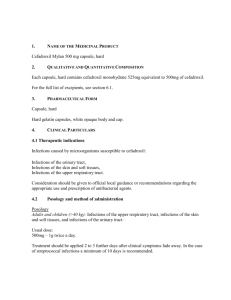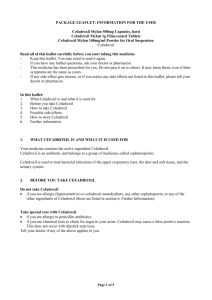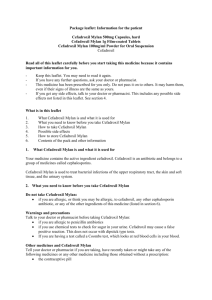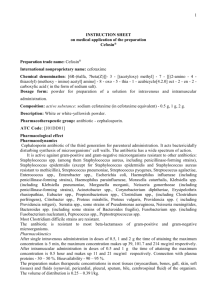Cefadroxil Mylan film-coated tablet ENG SmPC
advertisement
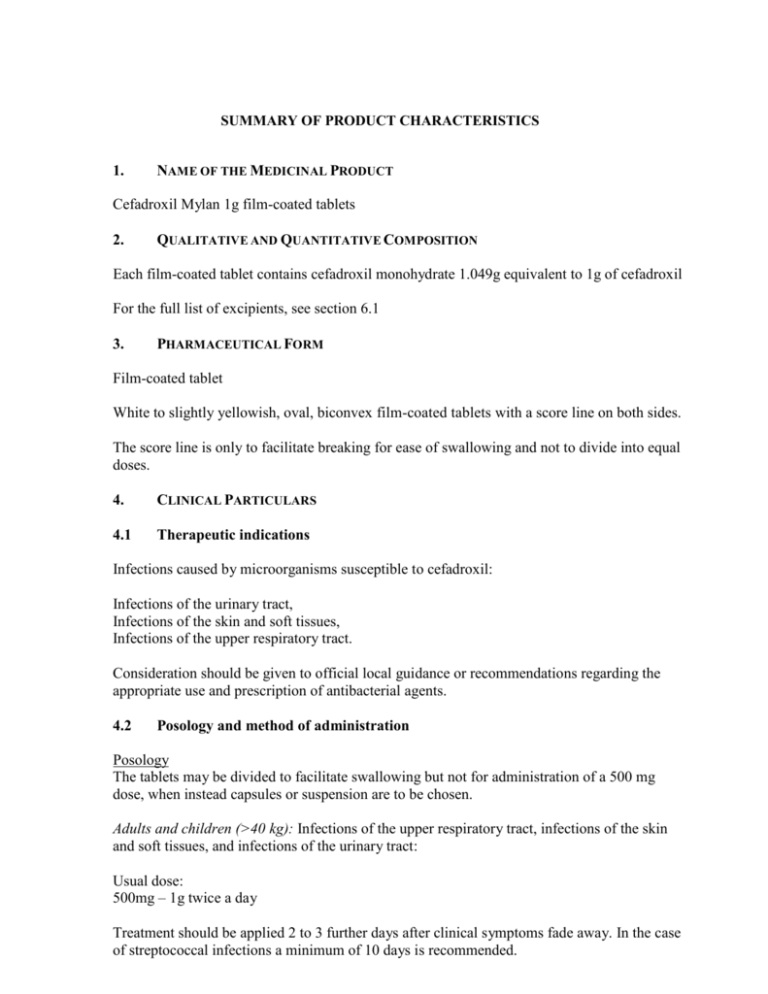
SUMMARY OF PRODUCT CHARACTERISTICS 1. NAME OF THE MEDICINAL PRODUCT Cefadroxil Mylan 1g film-coated tablets 2. QUALITATIVE AND QUANTITATIVE COMPOSITION Each film-coated tablet contains cefadroxil monohydrate 1.049g equivalent to 1g of cefadroxil For the full list of excipients, see section 6.1 3. PHARMACEUTICAL FORM Film-coated tablet White to slightly yellowish, oval, biconvex film-coated tablets with a score line on both sides. The score line is only to facilitate breaking for ease of swallowing and not to divide into equal doses. 4. CLINICAL PARTICULARS 4.1 Therapeutic indications Infections caused by microorganisms susceptible to cefadroxil: Infections of the urinary tract, Infections of the skin and soft tissues, Infections of the upper respiratory tract. Consideration should be given to official local guidance or recommendations regarding the appropriate use and prescription of antibacterial agents. 4.2 Posology and method of administration Posology The tablets may be divided to facilitate swallowing but not for administration of a 500 mg dose, when instead capsules or suspension are to be chosen. Adults and children (>40 kg): Infections of the upper respiratory tract, infections of the skin and soft tissues, and infections of the urinary tract: Usual dose: 500mg – 1g twice a day Treatment should be applied 2 to 3 further days after clinical symptoms fade away. In the case of streptococcal infections a minimum of 10 days is recommended. Paediatric population This product should not be used in children under 6 years. Patients with impaired kidney function The half- life in plasma is prolonged with impaired kidney function. The recommended dose is 500 mg, but the interval between doses should be increased. With a creatinine clearance of 25-50 ml/min a dose may be given every 12 hours, with 10-25 ml/min every 24 hours and with creatinine clearance of less than 10 ml/min one every 36 hours. Method of administration For oral use. Cefadroxil should be taken with food. The tablets should be ingested with plenty of liquid. 4.3 Contraindications Hypersensitivity, or suspected hypersensitivity, to the active substance, other cephalosporins or to any of the excipients listed in section 6.1. 4.4 Special warnings and precautions for use Special caution is called for when known penicillin allergy is present, as cross-allergy may occur. As a consequence of treatment with cephalosporins, in exceptional cases a false positive Coombs test has been reported. During treatment with cefadroxil, a false positive reaction for glucose in the urine may occur when Benedict´s or Fehling´s solutions, copper sulfate or Clinitest tablets are used in the test, but not in the enzyme test with Clinistix. 4.5 Interaction with other medicinal products and other forms of interaction Combination with contraceptive preparations may require dose adjustment. Certain antibiotics may, in rare cases, be capable of reducing the effect of contraceptive pills by interfering with the bacterial hydrolysis of steroid conjugates in the intestine and thereby affecting the reabsorption of unconjugated steroid and causing the plasma levels of active steroid to fall. This unusual interaction might occur in women with high excretion levels of steroid conjugate via their bile. Some 60 pregnancies have occured in English women undergoing treatment with contraceptive pills who have simultaneously taken antibiotics, principally ampicillin, amoxicillin and tetracyclines. There are reports of negative studies with trimethoprimsulpha, roxithromycin and clarithromycin, but the studies were on a very small scale. - The occurrence of diarrhoea may impair the absorption of other medicaments and therefore lead to an impairment of their efficacy. Forced diuresis leads to a decrease of cefadroxil blood levels. - - - 4.6 Cefadroxil should not be combined with bacteriostatic antibiotics (e.g tetracycline, erythromycin, sulfonamides, and chloramphenicol) since an antagonistic effect is possible. Treatment with cefadroxil in combination with aminoglycoside antibiotics, polymyxin B, vancomycin, colistin or high-dose loop diuretics should be avoided since such combinations can potentiate nephrotoxic effects. The concomitant administration of probenecid can produce higher and sustained concentrations of cefadroxil in the serum and in the bile. As with other cephalosporins (in high doses) frequent checks on coagulation parameters are necessary during concomitant long-term use of anticoagulants or thrombocyte aggregation inhibitors to avoid haemorrhagic complications. Fertility, pregnancy and lactation Pregnancy Studies in animals did not reveal any teratogenic effect. In the absence of teratogenic effects in animals, a malformative effect is not expected in humans. To present time, substances causing malformation in humans have been shown to be teratogenic in animals during well-conducted studies in two species. In clinical practice, analysis of a large number of exposed pregnancies did not appear to reveal any malformative or foetotoxic effect specifically related to cefadroxil. However, absence of risk could be confirmed by epidemiological studies. Consequently, cefadroxil can be prescribed during pregnancy, if necessary. Breast-feeding Low levels of cefadroxil are excreted in breast milk and the ingested quantities are lower than therapeutic doses. Consequently, breast-feeding is possible when taking this antibiotic. However, breast-feeding (or treatment) should be discontinued if the infant develops diarrhoea, candidosis or a skin eruption. 4.7 Effects on ability to drive and use machines No effects have been observed. 4.8 Undesirable effects The adverse effects are presented according to the frequency of the cases, Very common (≥1/10); common (≥1/100 to <1/10); uncommon (≥1/1,000 to <1/100); rare (≥1/10,000 to <1/1,000); very rare (<1/10,000); not known (cannot be estimated from the available data). About 6% of patients taking the preparation suffer from undesirable effects. Infections and infestations: Uncommon: Clinical pictures due to a growth of opportunistic organisms (fungi) such as vaginal mycoses or thrush. - Blood and lymphatic system disorders: Rare: Eosinophilia, thrombocytopenia, leucopenia, neutropenia, agranulocytosis occur during prolonged use but subside upon discontinuation of therapy. Not known: haemolytic anaemia. - Nervous system disorders: Very rare: Headache, dizziness, nervousness, sleeplessness, fatigue. - Gastrointestinal disorders: Common: Nausea, vomiting, diarrhoea, dyspepsia, abdominal pain, glossitis. Not known: pseudomembranous colitis has been reported. - Hepatobiliary disorders: Rare: Minor elevation of serum transaminases (ASAT, ALAT) and alkaline phosphatases. - Skin and subcutaneous tissue disorders: Common: Pruritus, rash, allergic exanthema, urticaria. Rare: Angioneurotic oedema, drug fever, serum sickness-like reactions, Very rare: Immediate allergic reaction (anaphylactic shock). Not known: Stevens Johnson syndrome and erythema multiforme have been reported. - Musculoskeletal and connective tissue disorders Rare: arthralgia - Renal and urinary disorders: Rare: interstitial nephritis Reporting of suspected adverse reactions Reporting suspected adverse reactions after authorisation of the medicinal product is important. It allows continued monitoring of the benefit/risk balance of the medicinal product. Healthcare professionals are asked to report any suspected adverse reactions via [To be completed nationally] 4.9 Overdose Toxicity: Acute toxicity varies for different substances but generally speaking appears low. In cases of impaired kidney function, parenteral administration of high doses has given rise to neurological symptoms. Symptoms: In exceptional cases, anaphylactic shock may occur within 20-40 minutes; a fall in blood pressure with tachycardia or bradycardia, breathing difficulties, nausea, vomiting, exanthema, oedema. Toxic reactions: nausea, vomiting, diarrhoea, electrolytic disorders, reduced consciousness, muscular fasciculations, myoclonia, cramps, coma. Haemolytic reactions: kidney insufficiency, acidosis. Possibly coagulopathy and impairment of already impaired kidney function. Treatment: When justified; ventricle emptying, charcoal. Symptomatic treatment. Possibly dialysis in toxic reactions and impaired kidney function. 5. PHARMACOLOGICAL PROPERTIES 5.1 Pharmacodynamic properties Pharmacotherapeutic group: Antibacterials for systemic use, other betalactam antibacterials, first generation cephlasporins, ATC code: J01DB05 Mechanism of action Cefadroxil is a semisynthetic cephalosporin derivative for oral administration which inhibits bacterial wall synthesis of actively dividing cells by binding to one or more penicillin-binding proteins. The result is formation of a defective cell wall that is osmotically unstable. Cefadroxil exhibits time-dependent bactericidal activity. Breakpoints The following MIC breakpoints are suggested: Susceptible: <1 mg/lResistant: >16 mg/l Susceptibility Susceptible Intermediately susceptible Resistant Betahaemolytic streptocci group A, C, G and B Staphylococcus aureus1 Other staphylococci including S. saprophyticus1 Streptococcus pneumoniae and anaerobic streptococci E. coli2 Klebsiella spp. 2 Proteus mirabilis2 Moxarella catarrhalis3 Citrobacter spp, Enterobacter spp, Proteus ssp (indol positive) Serratia spp Morganella morganii Campylobacter Haemophilus influenzae Pseudomonas spp including Ps. aeruginosa, Clostridium difficile, Listeria monocytogenes, Legionella, Chlamydia and Mycoplasma spp Enterococci Anaerobic gramnegative rods 1 S. aureus and other staphylococci including betalactamase producing strains E. Coli and Klebsiella spp., P. mirabilis: Considered susceptible in lower urinary tract infection 3 M. catarrhalis: Betalactamase producing strains, which are in majority, are resistant 2 All betahaemolytic streptocci are susceptible to beta lactam antibiotics and no resistance has yet been observed. Cefadroxil cannot be used against gram positive rods with plasmid mediated betalactamase production (TEM, SHV) as the substance will be hydrolysed and inactivated. Thus, resistant isolates of E. coli, Klebsiella spp, and P. mirabilis may be encountered. There can be cross-resistance within the beta lactam antibiotics group (penicillins and cefalosporins). Penicillin resistant pneumococci and meticillin resistant Staphylococcus aureus are resistant to cefadroxil. Resistance can develop during treatment in the following species: Enterobacter, Citrobacter, Pseudomonas (predominately aeruginosa), Morganella and Serratia. 5.2 Pharmacokinetic properties Absorption Cefadroxil is stable in an acid environment, and is absorbed just as well in conjunction with food as without. Maximal serum concentration (approx. 16 microg/ml after a single dose of 500 mg cefadroxil) is attained about 1.5 hours after ingestion. Distribution About 20% of cefadroxil is bound to serum proteins. Elimination Cefadroxil is excreted via glomerular filtration and tubular secretion. After 24 hours, approx. 90% of the active substance will have been excreted in the urine. In people with normally functioning kidneys, the half- life of cefadroxil in serum is about 1 hour 20 minutes. After a single dose of 1 g of cefadroxil, sufficient concentrations of cefadroxil are present in the urine after 24 hours to combat the most commonly occurring urinal tract pathogens. 5.3 Preclinical safety data There is no preclinical data of relevance for the safety-judgement beyond what has already been considered in the Summary of Product Characteristics. 6. PHARMACEUTICAL PARTICULARS 6.1 List of excipients Core: Silica, colloidal anhydrous, sodium laurilsulfate, magnesium stearate, macrogol 6000, crospovidone, povidone, talc, cellulose microcrystalline. Film-coating: Titanium dioxide (E171), hypromellose, talc. 6.2 Incompatibilities Not applicable. 6.3 Shelf-life 3 years. 6.4 Special precautions for storage Keep the container in the outer carton in order to protect from light. 6.5 Nature and contents of container 6, 7, 8, 10, 16, 20 and 100 in securitainers – polypropylene containers and polypropylene lids. 6, 7, 8, 10, 16, 20 in blister strips – PVC/PVDC and aluminium foil 100x1 in blister unit dose – PVC/PVDC and aluminium foil Not all pack sizes may be marketed. 6.6 Special precautions for disposal and other handling No special instructions. 7. MARKETING AUTHORISATION HOLDER [To be completed nationally] 8. MARKETING AUTHORISATION NUMBER(S) [To be completed nationally] 9. DATE OF FIRST AUTHORISATION/RENEWAL OF THE AUTHORISATION [To be completed nationally] 10. DATE OF REVISION OF THE TEXT 2015-01-21
